Breaking: Autopsy reveals how Cyrus Jirongo died
Premium
Inside a Tigray farming town scarred by Ethiopian conflict
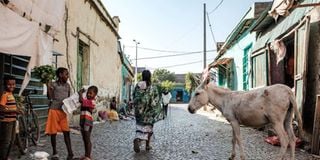
A view of a street near the market in Humera, Ethiopia on November 22, 2020.
What you need to know:
- The town lies near Ethiopia's borders with Sudan and Eritrea.
- Humera promised prosperity before the start of the conflict.
- Ethiopia's government denies TPLF claims that Eritrea is involved in the fighting.
Humera
A pair of burnt-out tanks now signals the entrance to the Tigray town of Humera, where the streets are lined with rubble and residents remain in shock after an Ethiopian army assault earlier this month.
The conflict between Ethiopia's federal government and the leaders of the northern Tigray region arrived quickly in the farming town, with artillery barrages bombarding commercial buildings and homes as residents fled or cowered in terror.
A communications blackout and restrictions have made reporting on the conflict difficult, but AFP journalists reached Tigray -- the first independent journalists to report from inside the conflict zone since fighting started -- and found the scars of conflict everywhere.
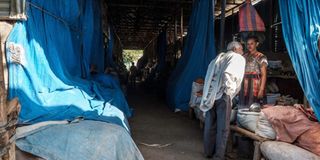
A man buys spices from one of the few open stalls at the market in Humera, Ethiopia on November 22, 2020.
"We didn't expect shelling," said Humera resident Getachew Berhane, a short, bald 42-year-old in a crisp yellow t-shirt.
"Suddenly, we started to hear war weapons, explosions, and then people panicked."
"I couldn't leave my house. I was terrified," he said, as an Ethiopian government official accompanying the AFP team listened in.
The Ethiopian army, battling forces loyal to the Tigray People's Liberation Front (TPLF), declared Humera "liberated" on November 12 after heavy clashes in the first days of the conflict.
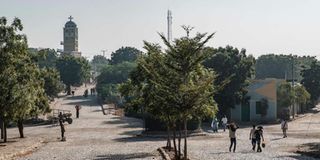
People walk in the streets of Humera, Ethiopia on November 22, 2020.
Bombs 'from the north
The power lines remain cut in Humera, a low-slung town of pastel-painted concrete buildings that was —until recently — home to around 30,000 people.
A gaping hole has been punched through the brick facade of the prominent Hotel Africa, while other structures have been peppered with bullet holes and gouged by shrapnel.
In the city centre, soldiers lolled on plastic chairs beneath the shade of trees.
Elsewhere, the city's remaining residents huddled around televisions run on diesel generators as military vehicles and tractors drove the cobbled and paved roads.
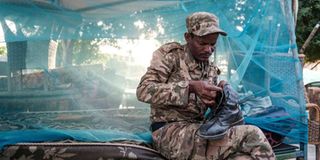
A member of the Amhara Special Forces fixes a boot at an improvised camp in front of a shop in Humera, Ethiopia on November 22, 2020.
The town lies near Ethiopia's borders with Sudan and Eritrea. Many of Humera's residents were among the first of the more than 30,000 Ethiopians who have fled into eastern Sudan for safety, leaving the city feeling abandoned.
Multiple people told AFP that during the battle they witnessed mortar bombs whistling in "from the north", meaning Eritrea.
Ethiopia's government denies TPLF claims that Eritrea is involved in the fighting, but acknowledges making use of Eritrean territory.
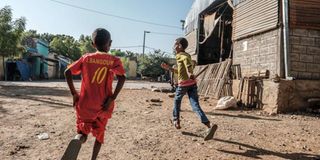
Children play next to the market in Humera, Ethiopia on November 22, 2020.
Hand-to-mouth living
At one tin-roofed residential compound, AFP was told that two women and an elderly man were killed by shelling and gunfire.
Two injured women still lay recovering from their wounds weeks later, strapped to makeshift stretchers.
One Humera resident said he knew of at least 10 people killed in his neighbourhood alone, however AFP was not permitted to visit the hospital to establish an accurate death toll.
A crossroads town in Ethiopia's far northwest, a hot, dry, agricultural lowland, Humera promised prosperity before the start of the conflict.
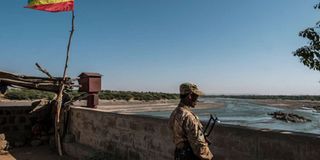
A member of the Amhara Special Forces on guard in Humera at the border crossing with Eritrea where an Imperial Ethiopian flag waves.
"This town was on the verge of development," said Tewodros Gebreselassie, a grim-faced, grey-bearded sesame trader.
"But now it's been brought back to hand-to-mouth living because of an unnecessary war."
Prime Minister Abiy Ahmed — last year's Nobel Peace Prize winner — announced military operations in Tigray on November 4, saying they were in response to TPLF attacks on federal army camps.
Hundreds are believed to have died since, while tens of thousands have fled their homes.
The intense fighting has rolled eastwards, into the mountainous highlands and towards the regional capital Mekele, a city of half a million.
On Sunday, Abiy gave TPLF leaders 72 hours to surrender ahead of a threatened all-out assault on Mekele.
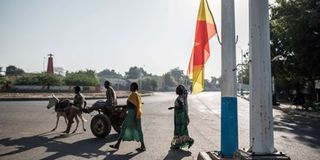
People walk by an Amhara regional flag in a street in Humera, Ethiopia on November 22, 2020.
Outsiders move in
With fighting having subsided in the west of Tigray, government officials are seeking to reimpose order in Humera.
The strategy appears to be to erase TPLF control partly by bringing administrators in from the neighbouring Amhara region, a move that risks inflaming ethnic tensions.
Throughout much of the west, federal soldiers are scarcely seen, instead security is maintained by Amhara's uniformed "special forces".
Civil servants have also arrived from Amhara to take over the administration of some Tigrayan towns and cities.
Daniel Wubet, an Amhara tourism official in a tracksuit and vest said he was in Humera to oversee "peacekeeping", procure basic necessities for the population and "educate" them on the TPLF's bad deeds.
Daniel, who had a Kalashnikov slung from his shoulder, has co-opted some local Tigrayans into the rebuilding exercise, among them Tewodros.

A young man charges phones at a bar in Humera, Ethiopia on November 22, 2020.
"They said I haven't done anything wrong and that I'm a pure Ethiopian," Tewodros explained of his appointment.
The presence of Amhara officials and soldiers will fuel fears of an occupation among Tigrayans, who are mired in a decades-old dispute over land that has, in the past, sparked violent clashes and continues to be a dangerous flashpoint.
Abrehu Fentahum, an elderly Amhara farmer living in western Tigray, said he looked forward to the land being returned to Amhara control, even though Daniel and others stress that this is not their goal.
"As long as I can remember, this land belonged to Amhara," until 1991 when "it was taken by the TPLF," he said.
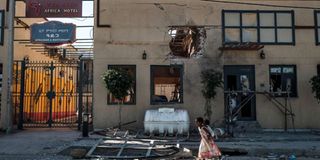
Children play in front of a hotel damaged by mortar shelling in Humera on November 22, 2020.
Already, visible traces of the TPLF are being expunged, its banners replaced by the green, yellow and red imperial-era flag of Amhara nationalism that now flies high at checkpoints and town squares.
These symbols will not allay Tigrayan fears of occupation, nor will the word "Amhara" scrawled on shuttered storefronts like a hastily graffitied claim of ownership.
Speaking to AFP by text message, TPLF leader Debretsion Gebremichael warned the presence of Amhara administrators and fighters would only prolong the conflict.
"This is one of their evil plans to weaken Tigray," he said.
"We'll continue to fight until they are cleared from all places."





